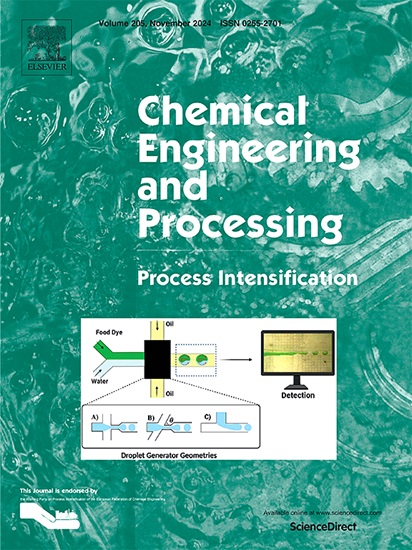Simulation of mixing process in viscous media by a turbulent mass diffusivity model in an impinging stream-rotating packed bed
IF 3.8
3区 工程技术
Q3 ENERGY & FUELS
Chemical Engineering and Processing - Process Intensification
Pub Date : 2025-06-24
DOI:10.1016/j.cep.2025.110423
引用次数: 0
Abstract
In this work, a three-dimensional numerical model is established to simulate the mixing process in viscous media in an impinging stream-rotating packed bed (IS-RPB). The realizable k–ε method is adopted to predict the turbulent flow, the high gravity environment is simulated by the sliding mesh model, and the turbulent mass diffusivity is calculated by the concentration variance and its dissipation rate εc formulations, so that the turbulent mass transfer process can be simulated without using empirical correlations. The simulated segregation index Xs is found to be in accordance with our previous experimental data. The fringe effect of the impinging stream is more pronounced in high viscosity systems, but it can be counterbalanced effectively by the RPB, leading to an enhancement in the mixing efficiency. Elevated liquid viscosity amplifies IS-RPB's liquid flow ratio sensitivity in mixing efficiency. Therefore, although IS-RPB demonstrates effective in viscous liquid mixing, the liquid impinging methodology optimization remains necessary to address the adverse effect on mixing when the liquid flow ratio is relatively high.

用紊流质量扩散率模型模拟碰撞流旋转填料床中粘性介质的混合过程
本文建立了一个三维数值模型来模拟碰撞流-旋转填料床(is - rpb)中粘性介质的混合过程。采用可实现的k -ε方法预测湍流流动,采用滑动网格模型模拟高重力环境,通过浓度方差c2及其耗散率εc公式计算湍流质量扩散系数,从而可以模拟湍流传质过程而不使用经验相关性。模拟的偏析指数Xs与我们之前的实验数据一致。撞击流的条纹效应在高粘度体系中更为明显,但RPB可以有效地抵消它,从而提高混合效率。液体粘度的升高使IS-RPB液流比对混合效率的敏感性增大。因此,尽管is - rpb在粘性液体混合中表现出了有效的效果,但为了解决液流比较大时对混合的不利影响,仍有必要对液击方法进行优化。
本文章由计算机程序翻译,如有差异,请以英文原文为准。
求助全文
约1分钟内获得全文
求助全文
来源期刊
CiteScore
7.80
自引率
9.30%
发文量
408
审稿时长
49 days
期刊介绍:
Chemical Engineering and Processing: Process Intensification is intended for practicing researchers in industry and academia, working in the field of Process Engineering and related to the subject of Process Intensification.Articles published in the Journal demonstrate how novel discoveries, developments and theories in the field of Process Engineering and in particular Process Intensification may be used for analysis and design of innovative equipment and processing methods with substantially improved sustainability, efficiency and environmental performance.

 求助内容:
求助内容: 应助结果提醒方式:
应助结果提醒方式:


